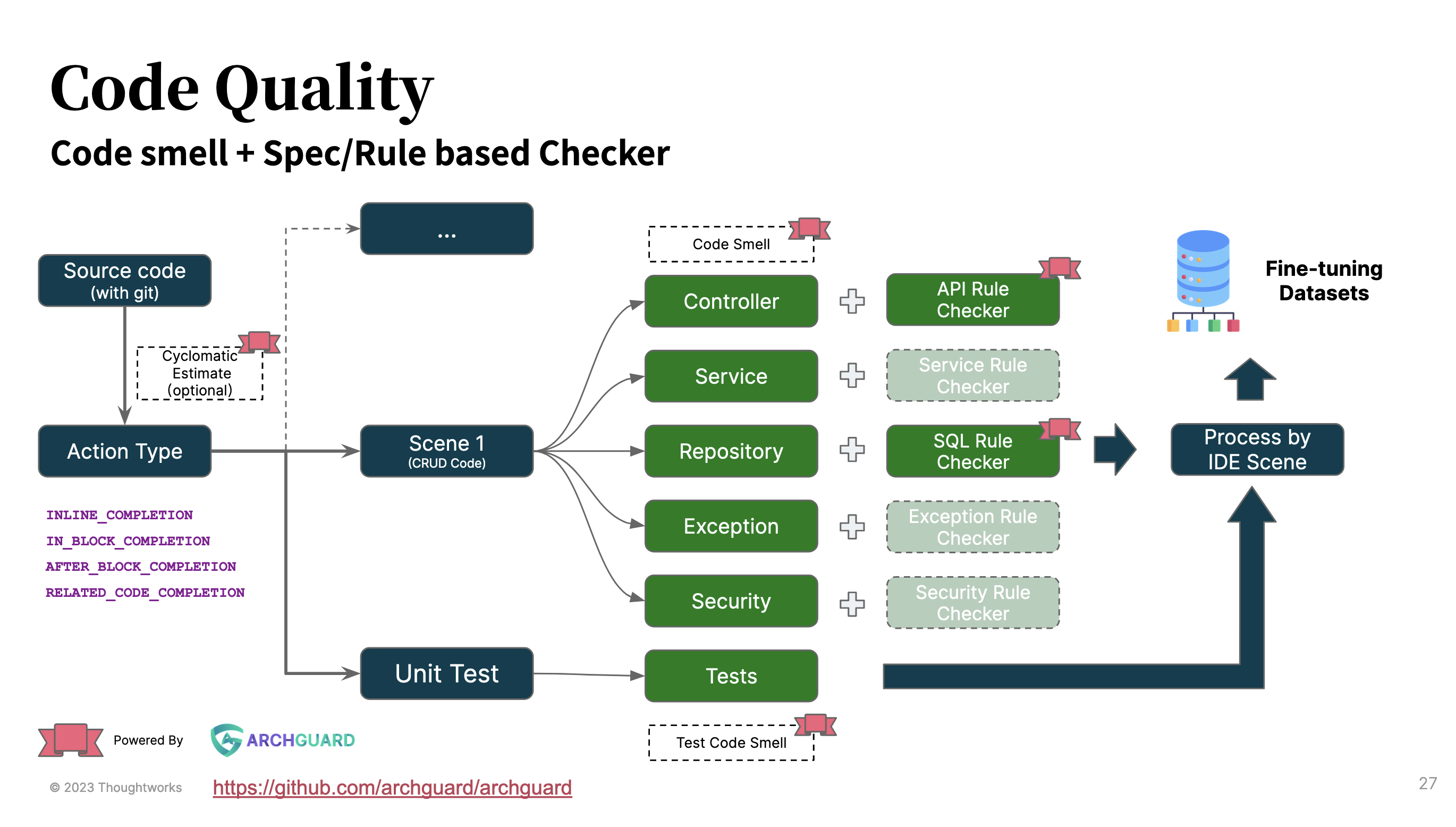Unit Eval is a code fine-tuning data framework that generates data from your existing codebase. Additionally, it includes benchmarking and evaluation tools for code LLM.
Docs: https://eval.unitmesh.cc/
Thanks to OpenBayes for providing computing resources.
Examples:
| name | model download (HuggingFace) | finetune Notebook | jupyter notebook Log | model download (OpenBayes) |
|---|---|---|---|---|
| DeepSeek 6.7B | unit-mesh/autodev-deepseek-6.7b-finetunes | finetune.ipynb | OpenBayes | deepseek-coder-6.7b-instruct-finetune-100steps |
| CodeGeeX2 6B | TODO | TODO | TODO |
Features:
- Code context strategy: Related code completion, Similar Code Completion
- Completion type: inline, block, after block
- Code quality filter and pipeline. Code smell, test smell, estimation nd more.
- Unique prompt. Integrated use of fine-tuning, evaluation, and tooling.
- Code quality pipeline. With estimate with code complex, bad smell, test bad smell, and more rules.
- Extendable customize quality thresholds. Custom rules, custom thresholds, custom quality type or more.
Keep the same prompt: AutoDev <-> Unit Picker <-> Unit Eval
AutoDev prompt template example:
Write unit test for following code.
${context.coc}
${context.framework}
${context.related_model}
```${context.language}
${context.selection}
```
Unit Picker prompt should keep the same structure as the AutoDev prompt. Prompt example:
Instruction(
instruction = "Complete ${it.language} code, return rest code, no explaining",
output = it.output,
input = """
|```${it.language}
|${it.relatedCode}
|```
|
|Code:
|```${it.language}
|${it.beforeCursor}
|```""".trimMargin()
)Unit Eval prompt should keep the same structure as the AutoDev prompt. Prompt example:
Complete ${language} code, return rest code, no explaining
```${language}
${relatedCode}
```
Code:
```${language}
${beforeCursor}
```
Before Check:
- FileSize: 64k
- Complexity: 1000
Optional quality type:
enum class CodeQualityType {
BadSmell,
TestBadSmell,
JavaController,
JavaRepository,
JavaService,
}Custom thresholds' config:
data class BsThresholds(
val bsLongParasLength: Int = 5,
val bsIfSwitchLength: Int = 8,
val bsLargeLength: Int = 20,
val bsMethodLength: Int = 30,
val bsIfLinesLength: Int = 3,
)Custom rules:
val apis = apiAnalyser.toContainerServices()
val ruleset = RuleSet(
RuleType.SQL_SMELL,
"normal",
UnknownColumnSizeRule(),
LimitTableNameLengthRule()
// more rules
)
val issues = WebApiRuleVisitor(apis).visitor(listOf(ruleset))
// if issues are not empty, then the code has bad smellfor examples, see: examples folder
see in config-examples
download the latest version from GitHub Release
- config project by
processor.yml - run picker:
java -jar unit-cli.jar
1.config the unit-eval.yml file and connection.yml
2.run eval: java -jar unit-eval.jar
PS:Connection config: https://framework.unitmesh.cc/prompt-script/connection-config
see in config-example
1.add dependency
dependencies {
implementation("cc.unitmesh:unit-picker:0.1.5")
implementation("cc.unitmesh:code-quality:0.1.5")
}2.config the unit-eval.yml file and connection.yml
3.write code
public class App {
public static void main(String[] args) {
List<InstructionType> builderTypes = new ArrayList<>();
builderTypes.add(InstructionType.RELATED_CODE_COMPLETION);
List<CodeQualityType> codeQualityTypes = new ArrayList<>();
codeQualityTypes.add(CodeQualityType.BadSmell);
codeQualityTypes.add(CodeQualityType.JavaService);
PickerOption pickerOption = new PickerOption(
"https://github.com/unit-mesh/unit-eval-testing", "master", "java",
".", builderTypes, codeQualityTypes, new BuilderConfig()
);
SimpleCodePicker simpleCodePicker = new SimpleCodePicker(pickerOption);
List<Instruction> output = simpleCodePicker.blockingExecute();
// handle output in here
}
} - abstract syntax tree: Chapi. Used features: multiple language to same data structure.
- legacy system analysis: Coca. Inspired: Bad Smell, Test Bad Smell
- architecture governance tool: ArchGuard. Used features: Estimation, Rule Lint (API, SQL)
- code database CodeDB. Used features: Code analysis pipeline
This code is distributed under the MPL 2.0 license. See LICENSE in this directory.





